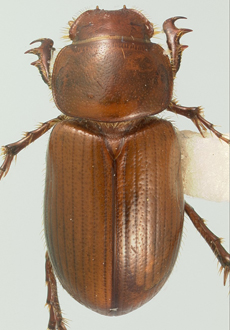 |
|||||||
|
|||||||
Cinacanthus Schmidt 1913
Cinacanthus Schmidt 1913: 121.
Photo by P. Skelley.
|
||
|
||
| Aphodiinae Overview | ||
| Aphodiini Key |
Type species. Aphodius militaris LeConte 1858: 65, by subsequent designation.
Diagnosis. Body length 4.0-5.7 mm, elongate, somewhat flattened; black except for distinct yellow pattern on elytra, which varies in extent, some being almost entirely black. Lateral pronotum with weak setal fringe. Elytra with distinct lateral setae in basal third. Notably sexually dimorphic in shape and sculpturing of head and pronotum.
Distribution. Western North America and Mexico.
Composition. Cinacanthus presently contains 6 species.
Cinacanthus coquilletti (Linell 1896: 722) [Aphodius], CA-NV-USA.
Cinacanthus crenicollis (Fall 1932: 189) [Aphodius], W-USA, Mexico.
= Aphodius spermophili Gordon 1973: 436.
Cinacanthus crescentus Gordon and Skelley 2007: 473, NV-USA.
Cinacanthus hirsutus (Brown 1928: 303) [Aphodius], NW-USA, SW-Canada.
Cinacanthus militaris (LeConte 1858: 65) [Aphodius], W-USA, Mexico.
Cinacanthus ulkei (Gordon 2006: 54) [Aphodius], CO-NE-USA.
Life History. Members of Cinacanthus are rodent dung specialists. Cinacanthus coquilletti and C. militaris have been collected in numbers from pocket gopher burrows. Other Cinacanthus spp. were found in ground squirrel and prairie dog burrows.
Larvae. Unknown.
References:
Gordon, R. D., and P. E. Skelley. 2007. A monograph of the Aphodiini inhabiting the United States and Canada (Coleoptera: Scarabaeidae: Aphodiinae). Memoirs of the American Entomological Institute 79: 580 pp.
|
||||
| Author: Paul Skelley Generated on: 28/APR/08.....Last modified: 28/APR/08 University of Nebraska State Museum - Division of Entomology |
